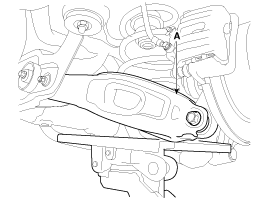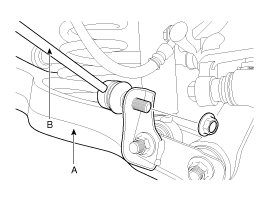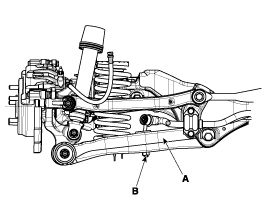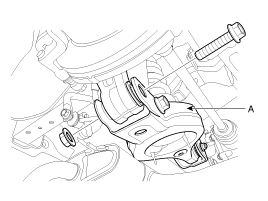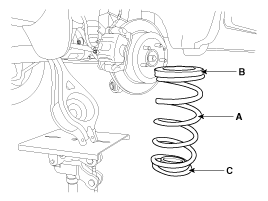Hyundai Tucson: Rear Suspension System / Rear Coil Spring Repair procedures
| Removal |
| 1. |
Remove the rear wheel & tire.
|
| 2. |
Support the rear lower arm (A) with a jack as shown in the illustration.
|
| 3. |
Loosen the nut and then remove the rear stabilizer link (B) with the rear lower arm (A).
[4WD]
[2WD]
|
| 4. |
Loosen the bolt & nut and then remove the rear lower arm (A) with the rear axle.
|
| 5. |
Remove the spring (A), the upper pad (B) and the lower pad (C).
|
| 6. |
Installation is the reverse of removal. |
| 7. |
Check the rear alignment.
(Refer to Rear Suspension System - "Rear Alignment") |
| Inspection |
| 1. |
Check the spring for distortion, aging or damage. |
| 2. |
Check the spring upper pad and lower pad for aging or damage. |
 Rear Cross Member Repair procedures
Rear Cross Member Repair procedures
Replacement
1.
Remove the rear wheel & tire.
Tightening torque :
88.3 ~ 107.9 N.m (9.0 ~ 11.0 kgf.m, 65.1 ~ 79.6 lb-ft)
Be careful not to damage to the hub bolts ...
 Tires/Wheels
Tires/Wheels
...
Other information:
Hyundai Tucson (LM) 2010-2015 Service Manual: Front Hub / Knuckle / Tone Wheel Repair procedures
Removal
1.
Remove the front wheel and tire (A) from front hub .
Tightening torque:
88.2 ~ 107.8 N.m (9.0 ~ 11.0 kgf.m, 65.0 ~ 79.5 lb-ft)
Be careful not to damage to the hub bolts when removing the front wheel and tire (A).
2.
Remove the brake caliper mounting ...
Hyundai Tucson (LM) 2010-2015 Service Manual: Side Impact Sensor (SIS) Repair procedures
Removal
Pressure Side Impact Sensor
•
Removal of the airbag must be performed according to the precautions/procedures described previously.
•
Before disconnecting the side impact sensor connector(s), disconnect the side airbag connector(s).
•
Do not t ...


